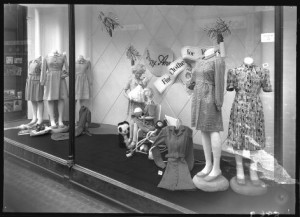For as long as I can remember I have loved department stores so when the TV series, Mr Selfridge, launched in 2013 it was right up my street. Here was the captivating story of a towering London landmark, one I knew well. I soon realised how little I knew, however, about its charismatic founder, Harry Selfridge. Inspired, I did some digging and in the process came to love and respect Harry, one of the retail world’s most innovative and enterprising individuals. My debut novel, When Harry Met Rose: Mr Selfridge and the Search for Love, is a tribute to him, an imagined version of how he met and fell in love with the Chicago debutante, Rose Buckingham.
It’s impossible to write about Harry without writing about shopping too. In 1890, when he and Rose met, Harry was working at Chicago’s prestigious department store, Marshall Field, and the more I became immersed in late nineteenth century Chicago the more I found memories crowding in of my own shopping experiences as a small child in the North East of England.
Harry Selfridge succeeded in changing the face of shopping for ever and I, for one, am grateful. Although he belonged to a different time, what struck me as I was writing about him was just how much his pioneering style managed to touch my own life.
As a child, growing up in the North East, visiting a department store held a certain mystique for me. Newcastle boasted big and impressive stores – Fenwick’s, Farnons, Binns, Bainbridges – filled with great treasures. It wasn’t just the range of merchandise that was breathtaking, it was the whole experience of being in those stores. Even taking the lift – invariably operated by a man in uniform who called out the floors and the goods to be found on each one – was thrilling.
Both my parents worked in department stores, my mother on the shop floor, my father in management. They were very much in my mind during the writing of When Harry Met Rose, and the book is dedicated to them. In my mother’s day, shop work was glamorous and sought-after. Staff had to dress up and undergo inspections before going onto the shop floor. I remember my mother saying it would have been unthinkable not to wear make-up for work. When I remember her now odd little memories come to mind: flawless skin, Max Factor block mascara, Gordon Moore’s cosmetic toothpaste, red lipstick, a love of Black Magic chocolates. I recall my father going off to work in his temperamental red Mini, later replaced by a more reliable Vauxhall Victor. Always in a suit, his shoes – and ours – polished to a high shine, my father wore cufflinks, had dress shirts with detachable collars, and was moved to tears by the Austrian tenor, Richard Tauber.
The department stores of my childhood were opulent, extravagant places, the women behind the counters immaculate and perfumed. Even the simple act of making a purchase had a sense of wonder about it. In the nineteen-sixties, stores recorded sales by hand in duplicate on slips of paper that went into a capsule, along with the customers’ money, and hurtled off along overhead chutes to an unseen cashier. Back would come the change by the same mechanism. I would watch, wide-eyed, as all around the store these little capsules shot back and forth and somehow, miraculously, always managed to end up where they were meant to. Years later, on a filming trip in Sri Lanka, I saw the same system still in use in a shop in the capital, Colombo, and memories flooded back.
When I was small I relished being taken to see my father at his place of work. I loved the wood-panelled lift with its concertinaed metal gates, the catwalk shows on the fashion floor, the exquisite gift-wrapping of my modest purchases … and the unspoken understanding that the customer is always right. It was Harry Selfridge who first came up with that assertion, by the way. It’s clear to me now how much the stores of my childhood owed to Harry, a man of vision with a heartfelt passion for retail.
When Harry Met Rose: Mr Selfridge and the Search for Love is available on Amazon UK here and on Amazon US here
Maria Malone produced the DVD behind-the-scenes bonus feature for Mr Selfridge, Series 2.
Featured Image of Northumberland Street, Newcastle, 1968, and Bainbridges’ shop window, 1947, courtesy of Tyne & Wear Archives & Museums

